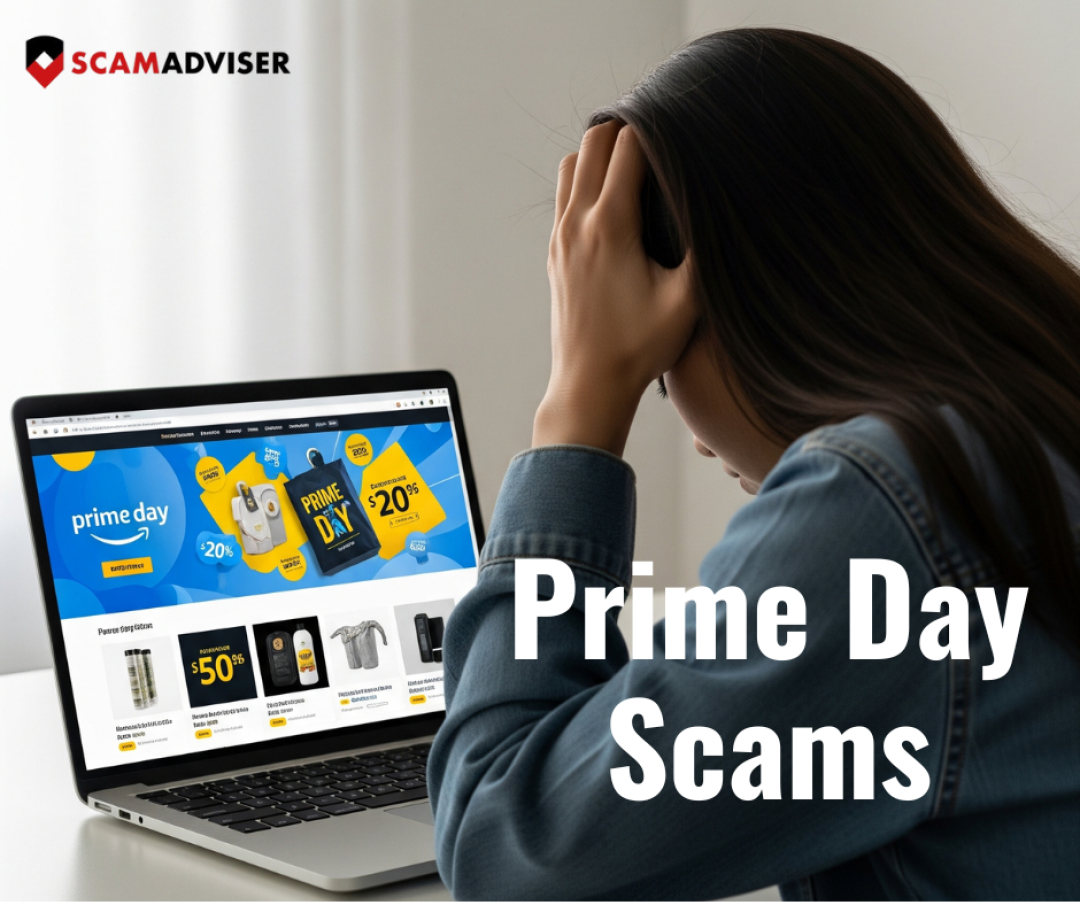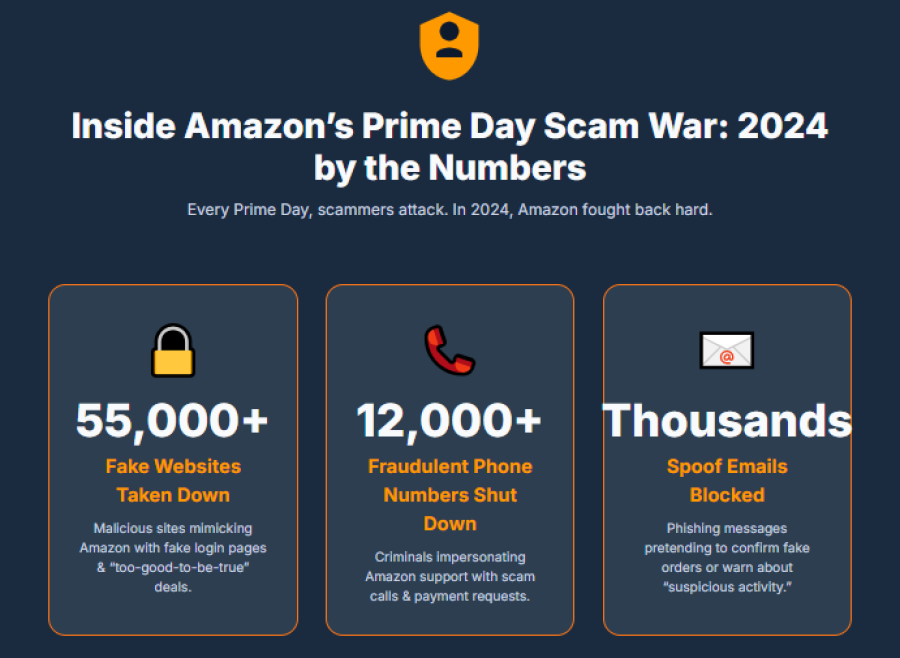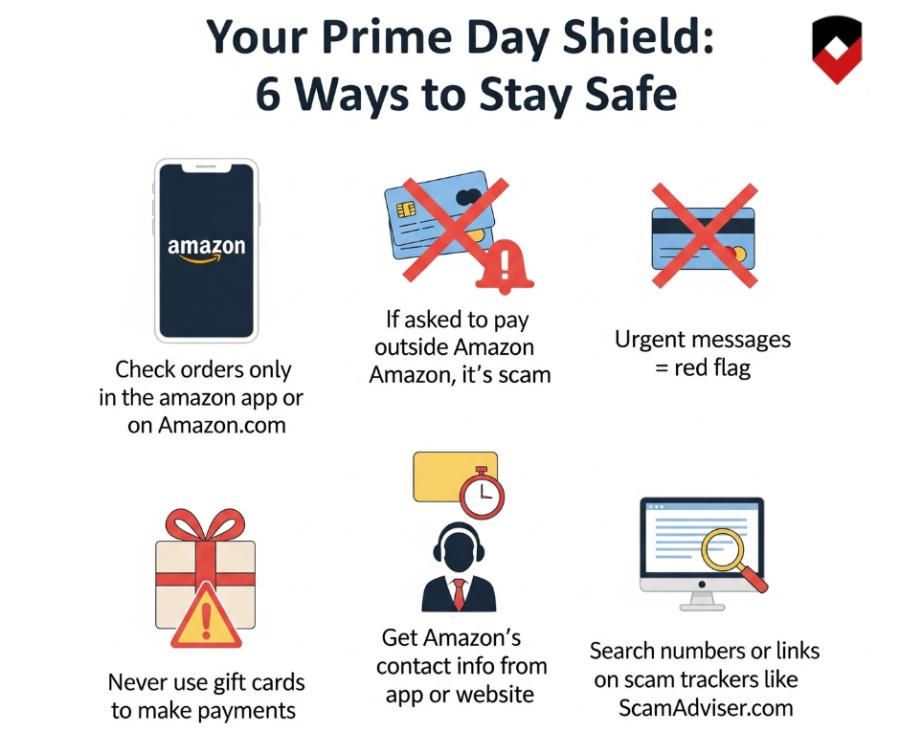Scammers Love Prime Day More Than You Do — Here’s How to Outsmart Them

Author: Adam Collins
Imagine this: You suddenly receive a "Thank you for your order" email for something you never bought. It looks surprisingly legitimate, complete with Amazon's logo and a prominent "Cancel this purchase" button. One click on that button is all it takes for the damage to begin.
Prime Day Scams: Scammers' Favorite Hunting Season
While you're hunting for lightning deals this Prime Day, cybercriminals are watching, ready to strike.
Their primary weapon? Impersonation. Their disguise? Amazon.
Every year, Amazon vigorously combats tens of thousands of phishing websites, fake support calls, and shady text messages. In 2024 alone, they shut down over 55,000 fake websites and 12,000 scam phone numbers tied to Prime Day-style impersonation attacks.

But here’s the unsettling truth: scammers aren’t slowing down. They’re evolving. And this year, they’re betting you’ll be too distracted by deals to notice when something feels off.
Common Prime Day Scams to Watch Out For
Be on high alert for these common scam tactics hitting inboxes, phones, and search results during Prime Day:
- Fake Order Confirmations: You get a message about an expensive item you never bought – like a new laptop or a high-end appliance – and a tempting "Click here to cancel" button. Clicking this link doesn't cancel anything; it sends you to a fake Amazon login page designed to steal your password and potentially your entire identity.
- "Account Suspended" Alerts: These urgent messages claim your Prime membership is being suspended for things like “Suspicious Account Activity” or you've been double-charged, demanding immediate action. The goal? To induce panic and force a quick click before you can think clearly.
- Calls from Fake Amazon Reps: Scammers call, expertly impersonating Amazon's fraud team. They'll tell you there's suspicious activity on your account and pressure you to "verify" your details by sharing credit card numbers or even installing malicious software on your device.
- Deal Links That Aren't Deals At All: You see an ad for a product with an unbelievable 90% discount. Clicking leads you to a lookalike website. You enter your payment information, the money is gone, and the product never existed.
Before You Click, Ask Yourself:
- Did I actually order this item? Always cross-reference with your official Amazon app or website.
- Is this deal unbelievably good? If it seems too perfect, it probably is a scam.
- Is there extreme pressure or urgency? Scammers thrive on panic and rushed decisions.
- Am I being asked to pay in an unusual way? Amazon will never ask you to pay with gift cards, wire transfers, or over the phone.
Your Prime Day Shield: 6 Ways to Stay Safe
Amazon has shared six golden rules to protect yourself — here they are, sharpened for real-world use:
✅ 1. Always Check Your Purchase History — Inside the App Only. Got a suspicious order alert? Do not click the email link. Instead, open the Amazon app or go directly to amazon.com, sign in, and check your order history. If it’s not there, it’s a scam.
✅ 2. Never Trust a Payment Request Outside Amazon. Amazon will never ask you to: * Pay over the phone * Wire money * Buy gift cards * Install any software. If anyone does? They're lying. End the call immediately. Close the browser window.
✅ 3. Watch for Manufactured Urgency. Scammers want you to act fast — because if you slow down, you’ll notice the red flags. If an email says “Only 15 minutes left to stop this charge” or “Act now to keep your account,” pause. It’s likely a setup.
✅ 4. Gift Cards Are for Gifting — Not for Payments. Amazon will absolutely never ask you to pay for anything using gift cards. If someone asks you to, it’s always, unequivocally, a scam.
✅ 5. Don’t Call Back Unknown Numbers. If you need Amazon support, go directly through the official Amazon app or website to find their contact information. Do not trust numbers sent via email or found in sketchy search results. Scammers seed fake “Amazon” numbers all over the internet.
✅ 6. Do Your Homework — and Help Others Do Theirs. Before acting, quickly check if others have reported the same scam. Tools like the BBB Scam Tracker let you search scam phone numbers, emails, and links to see if they’ve already been flagged by other consumers.

Act Fast: What to Do If You've Clicked a Scam
If you suspect you've fallen victim to a Prime Day scam, don't panic, but act immediately:
- Change your Amazon password immediately.
- Enable two-factor authentication (2FA) on your Amazon account if you haven't already. This adds an extra layer of security.
- Contact your bank or credit card company if you entered any payment information on a fake site.
- Report the scam to Amazon at stop-spoofing@amazon.com (for customers) or reportascam@amazon.com (for non-customers).
- Monitor your financial statements closely for any suspicious activity.
Amazon's War on Scammers: What They Do Behind the Scenes
Yes, Amazon is defending you. Their fraud-fighting army includes:
- Machine learning scientists hunting patterns in real-time
- Thousands of dedicated fraud analysts and investigators
- Law enforcement collaborations that have taken down counterfeit networks
- The A-to-Z Guarantee, which protects buyers even when things go wrong
So, while Amazon provides robust protection, during Prime Day, you are the first line of defense.
Frequently Asked Questions (FAQ) about Prime Day Scams
Here are answers to common questions people ask about staying safe during Prime Day:
Q: Is Prime Day even real?
A: Yes, Prime Day is a very real annual sales event hosted by Amazon! It typically runs for multiple days in July, offering significant discounts exclusively for Amazon Prime members. Many other retailers also launch competing sales during this period. The event is real, but the scams built around it are also very real.
Q: Is Amazon Prime Day safe to shop on?
A: Yes, shopping on Amazon's official platform during Prime Day is generally safe. Amazon has robust security measures. The danger comes from scammers who try to trick you into leaving the legitimate Amazon platform through fake emails, texts, or ads, leading you to fraudulent websites or convincing you to reveal personal information. Stick to the official Amazon website or app.
Q: How can I tell if an Amazon email or text is real?
A: Legitimate Amazon emails come from an @amazon.com domain. Always look for generic greetings ("Dear Customer"), poor grammar, unusual formatting, or blurry logos. The safest way to verify an order or message is to open your Amazon app or go directly to amazon.com and check your "Message Center" under "Your Account." All genuine Amazon communications will appear there.
Q: Can scammers really create fake Amazon websites? How do I spot them?
A: Yes, scammers create highly convincing fake websites (sometimes called "typosquatting"). Always check the URL carefully for subtle misspellings (e.g., amaz0n.com, arnazon.com, amazon-prime.net) or extra words in the domain. A genuine Amazon URL will almost always start with https://www.amazon.com/. The best defense is to type amazon.com directly into your browser or use the official Amazon app instead of clicking links in emails, texts, or social media ads.
Q: Will Amazon ever call me and ask for my password or credit card number?
A: No, absolutely not. Amazon will never call and ask for your login credentials, passwords, credit card numbers, gift card codes, or request remote access to your computer. If you get a call like this, hang up immediately – it's a scam.
Q: Why am I getting charged for Amazon Prime when I don't have it?
A: This can be a sign of several things. It could be an unauthorized charge from a scammer who obtained your card details. However, it's also common for people to accidentally sign up for a free trial that auto-renews, or someone in your household with access to your card might have subscribed.
- Check your Amazon account directly: Log into amazon.com or the app, go to "Account & Lists" > "Your Prime Membership" or "Memberships & Subscriptions" to see if an active membership is linked to your account.
- Check other family members' accounts: If others use your payment method, they might have signed up.
- Review your bank/card statements: Look for the exact charge details. If you can't find a corresponding Prime membership on any of your Amazon accounts, contact your bank or credit card company immediately to dispute the charge and potentially get a new card.
Q: What if a Prime Day deal seems too good to be true?
A: It probably is. While Prime Day offers great discounts, be extremely wary of items advertised at unrealistic prices (e.g., a new high-end TV for $50). Scammers use these "bait" offers to trick you into clicking on fake links and revealing your payment information. Always check seller ratings and reviews on the actual Amazon site for unfamiliar sellers.
Q: What's the best way to report an Amazon scam?
A: You can forward suspicious emails to Amazon at stop-spoofing@amazon.com. If you've been targeted by a phone scam or other impersonation, report it to Amazon at reportascam@amazon.com. You can also report phishing sites to the FTC at ReportFraud.ftc.gov. Reporting helps shut down fraud faster.
Bottom Line: A Deal Isn’t a Deal If It Costs You Your Identity
Prime Day is supposed to be exciting – a chance to snag amazing deals. But for scammers, it’s prime opportunity season.
You might come for the $29 smartwatch, but leave with a frozen account, drained funds, and a deep sense of violation.
So here’s your power move:
Slow down. Stay sharp. And question everything that looks just a little too perfect.
In this season, the smartest thing you can add to your cart is caution. Share this article with friends and family to help them stay safe this Prime Day!
Before you click, check with ScamAdviser.com—it’s a quick way to verify websites, phone numbers, crypto wallets, and even IBANs. On mobile? No worries—the ScamAdviser app has you covered 24/7, keeping you safer wherever you browse.
Report a Scam!

Have you fallen for a hoax, bought a fake product? Report the site and warn others!
Scam Categories
Help & Info
Popular Stories
As the influence of the internet rises, so does the prevalence of online scams. There are fraudsters making all kinds of claims to trap victims online - from fake investment opportunities to online stores - and the internet allows them to operate from any part of the world with anonymity. The ability to spot online scams is an important skill to have as the virtual world is increasingly becoming a part of every facet of our lives. The below tips will help you identify the signs which can indicate that a website could be a scam. Common Sense: Too Good To Be True When looking for goods online, a great deal can be very enticing. A Gucci bag or a new iPhone for half the price? Who wouldn’t want to grab such a deal? Scammers know this too and try to take advantage of the fact. If an online deal looks too good to be true, think twice and double-check things. The easiest way to do this is to simply check out the same product at competing websites (that you trust). If the difference in prices is huge, it might be better to double-check the rest of the website. Check Out the Social Media Links Social media is a core part of ecommerce businesses these days and consumers often expect online shops to have a social media presence. Scammers know this and often insert logos of social media sites on their websites. Scratching beneath the surface often reveals this fu
So the worst has come to pass - you realise you parted with your money too fast, and the site you used was a scam - what now? Well first of all, don’t despair!! If you think you have been scammed, the first port of call when having an issue is to simply ask for a refund. This is the first and easiest step to determine whether you are dealing with a genuine company or scammers. Sadly, getting your money back from a scammer is not as simple as just asking. If you are indeed dealing with scammers, the procedure (and chance) of getting your money back varies depending on the payment method you used. PayPal Debit card/Credit card Bank transfer Wire transfer Google Pay Bitcoin PayPal If you used PayPal, you have a strong chance of getting your money back if you were scammed. On their website, you can file a dispute within 180 calendar days of your purchase. Conditions to file a dispute: The simplest situation is that you ordered from an online store and it has not arrived. In this case this is what PayPal states: "If your order never shows up and the seller can't provide proof of shipment or delivery, you'll get a full refund. It's that simple." The scammer has sent you a completely different item. For example, you ordered a PlayStation 4, but instead received only a Playstation controller. The condition of the item was misrepresented on the product page. This could be the